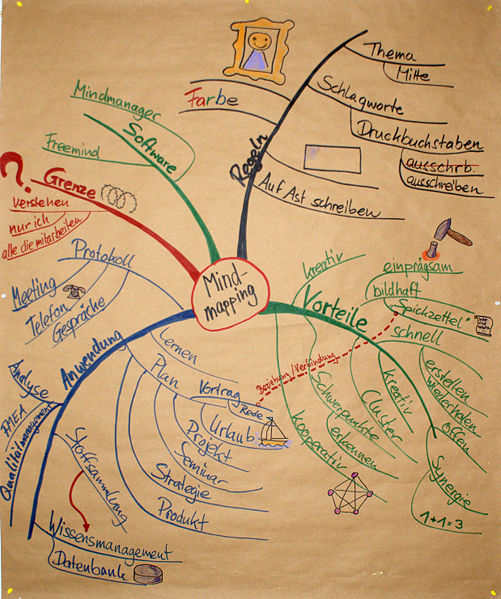Cultural Awareness and Expression
Unit 3: Creativity
|
|
 |
This Project has been funded with support from the European Commission. This communication reflects the views only of the author, and the Commission can not be held responsible for any use which may be made of the information contained therein.
|
 |
Getting started
Upon completion of this unit you shall be able to
- know something about your own creativity
- know a few methods to stimulate your creativity
- use these methods accordingly
Introduction
This unit is all about creativity!
Let's get started – but we did that already....
Remember Brainstorming? Yes? No? - Don't worry, we will show it again – later...
Let’s get started.

Every student chooses a partner. Every small group discusses and fills out the questionnaire below. Ideally this is done in an interview situation, one person asks the other and takes notes.
If there is enough time it is possible to do it in threes. One students asks the questions, one answers and the third takes notes
But you can do it on your own as well, if you prefer or if there is no group setting possible.
Questionnaire on Creativity
- How did your creativity show when you were a child?
- How does it show today?
- Do you like drawing? If yes, what do you like drawing?
- Do you like writing letters or other texts? Can you tell us some examples?
- Do you like singing? What kind of music do you like?
- Do you like paining or do you like using colours? Did you use these in the last couple of months?
- Do you like watching films or reading books?
- How does your creativity show in your free time?
- Do you easily find new solutions or new ideas for problems or challenges? Can you tell us more about that?
- How does your creativity show in your work?
- What was your greatest success while using your creativity?
- What's the source of your creativity and inspiration?
- How can you use this source for your life?
What is Creativity?
Creativity is a mental process involving the discovery of new ideas or concepts, or new associations of the existing ideas or concepts, fueled by the process of either conscious or unconscious insight.
It is very much associated with arts, as the whole process of doing a work of arts can only be done if you are creative.
However, creativity is also much needed in everyday life and work situations. If there are problems which can't be solved by a traditional way it is very advisable to come up with something new. This “finding something new” is creativity.
Brainstorming – a repetition ;-)
In order to create new ideas and approaches in a group of people, brainstorming is a very useful method as you probably noticed in Unit I.
Here we will show you how it works again.
Brainstorming
is a method for finding ideas. Brainstorming encourages the creation of new, unusual ideas in a group.
How does it work?
Everyone mentions everything that springs to their minds on a certain topic.
A moderator takes notes of all ideas, proposals, opinions and objections – ideally somewhere where everyone can see it (whiteboard, flip chart etc.)
There are no limits on the creation of ideas, everybody can react to anything someone else had said and can develop it further.
Ideas can be combined to something new.
Important: Judgements or comments are not allowed!
The following rules apply:
5 to 15 participants
Equality of all participants
Duration of the session: 10 to 30 minutes
Free flow of ideas
Quantity before quality – the focus lies on the production of as many ideas as possible
No criticism or deragatory comments
The outcome can later be structured and worked on.
The ideas are a first collection on a certain topic.
Usually there are a lot of very good suggestions to work on.
How can you use this method?
for finding ideas
for working on a complex issue
for finding headings |

Mindmaps
Another helpful method to get to your creative ressources is mindmapping.
The purpose of this method is to activate the mind and to map the thoughts. It is used to structure complex issues, to collect new ideas, to summarize a discussion, to take notes,...
- The topic or question is written (and drawn) in the middle of a large sheet of paper.
- Central ideas are put in tree branches which spring out of the topic,
- On every tree branch smaller tree branches which are logically connected are attached.
- The mind map can resemble a tree, a map, a river with smaller tribuatries
- A mind map is open. Thoughts and ideas can always be added.
- Colours can show the significance of every single tree branch.
- Symbols and drawings are very welcome.

Summary
-
Creativity is a mental process involving the discovery of new ideas or concepts, or new associations of the existing ideas or concepts, fueled by the process of either conscious or unconscious insight.
-
There a many methods to stimulate creativity, two of the most widely used are brainstorming and mind mapping.
|
Picture credit:
Mindmap:
Source: http://de.wikipedia.org/w/index.php?title=Datei:Pinwand-Mindmap.jpg&filetimestamp=20080423090644
License: public domain






